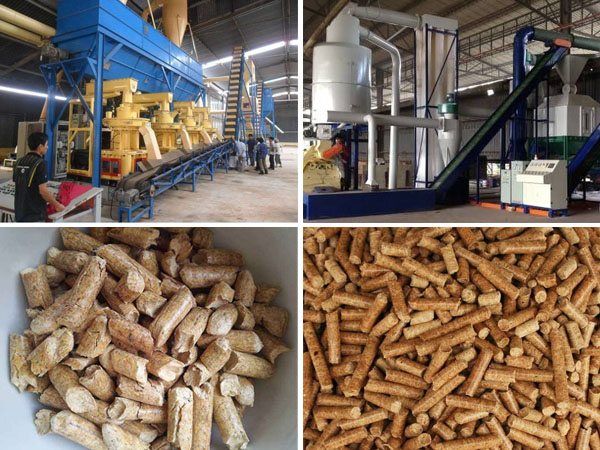Solutions to the appearance abnormality of pellet produced by pellet machine
When processing sawdust pellets with pellet machine, sometimes the appearance of wood pellet is abnormal. Then, what are the causes for the problem and how to solve it? The following are the causes and improvement methods of common abnormal appearance of sawdust pellets.

1. The sawdust pellet is bent with many cracks on one side.
This phenomenon is usually caused when the sawdust pellets leave the ring die. In the production of pellet machine, when the cutter location is far away from the ring die surface and the blade is blunt, pellets extruded from die are easy to be broken or torn apart by the cut knife rather than being cut off. Then, some sawdust pellets present many cracks and bend to one side. These sawdust pellets often break from these cracks when they are put into the cooler for cooling or in transportation, resulting in excessive amount of sawdust pellet powder or too short pellets.
Improving measures:
1) Increase the compression force of the ring die on wood pellets, that is, increase the compression ratio of the ring die, thus increasing the density and hardness value of the pellets;
2) Make the raw material of sawdust pellets crushed to a finer degree so as to improve the density of the sawdust pellets and prevent the sawdust pellets from being loose;
3) Adjust the distance between the cutting tool and the surface of the ring die, usually the distance between the tool mouth and the outside surface of the ring die is not greater than the diameter of sawdust pellets produced, or replace with a sharp cutting blade.
2. Horizontal cracks cross the entire sawdust pellets.
Similar to the phenomenon in case 1, the crack occurred on the cross-section of the sawdust pellets, but the pellets did not bend. This can happen when shaggy wood chips containing more fiber are granulated. When making sawdust pellets with these materials, the cross section of pellets produced would have horizontal cracks due to the the expansion of fiber.
The method of improvement is to increase the compression force of ring die on wood pellets, that is, to increase the compression ratio of ring die. The maximum length of the fiber can not exceed one third of the particle size. Reduce the output to lower the speed of sawdust pellets through the die hole and increase the density.
3. Vertical cracks of sawdust pellets.
In the process of production of sawdust pellets, due to the choice of the dryer type, the raw material can not be dried evenly so that the moisture content of raw material is uneven. After compression by the ring die, the vertical cracks of pellets would appear due to the effect of water and elasticity of raw material itself.
The improvement method is to improve the drying effect of dryer and increase the effective length of die hole.
4. Radial cracks of sawdust pellets from one source point
The main reason for this situation is that the raw material contains large wood chips. The materials with similar degree of fiber will make them squeeze and integrate with each other when granulating. The presence of large fibers will affect the interaction between fibers. It does not soften as easily as other finer materials, and when cooled, the difference in shrinkage due to varying degrees of softening leads to radial cracks.
The method of improvement is to control the fineness and evenness of powder feed raw materials properly, and use simple sieve to remove large wood chips before granulation.
5. Uneven surface of pellet materials
If the raw material for making pellets are not crushed or contains large particles which can not bond together with other raw materials and make the pellets uneven.
The improvement is to control the fineness of powder materials.
-------------------------------------------------------------------------------------------------------------------------------------------------------
News
- How to make biomass pellets?
- What are the reasons for different length of biomass pellets?
- Easily blocked parts of biomass pellet machine should be cleaned regularly
- How to improve the die life of wood pellet mill?
- How to adjust the pellet length of wood pellet mill?
- Four tips for making high quality pellets with biomass pellet machine
- The factors affecting the production speed of biomass pellet machine
- The use and precautions of the ring die in wood pellet mill
- The structure and working principle of ring die pellet machine
- What's the reason for abnormal noise or sudden stop of biomass pellet machine?
- The production process of biomass pellet plant
- Pellet machine makes the pollution become resource
- What is biomass pellet fuel?
- How to distinguish the quality of accessories in pellet machine?
- The advantages and application of pellet machine
- Make biomass energy with pellet machine
- Ring die adjustment of sawdust pellet making machine
- The performance difference between flat die pellet machine and ring die pellet machine
- Does the weather change affect biomass pellet machine?
- An effective solution to output reduction of pellet machine
- Advantages of pellet machine
- Solutions to the appearance abnormality of pellet produced by pellet machine
- Five advantages of pellet machine
- How to make the service life of die in pellet mill longer?
- Matters needing attention in the application of pellet mill
